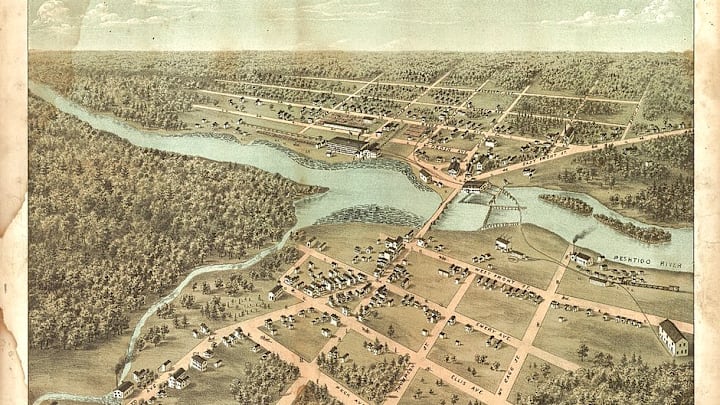The Great Peshtigo Fire erupted on October 8, 1871, devastating 1.2 million acres of land and killing more than 2500 people in northern Wisconsin and Michigan. That’s more deaths by fire from a single incident than any other in the United States. And in one of the most unfortunate coincidences in American history, it happened on the same night as a better-known, yet much smaller, fire—the Great Chicago Fire, which ravaged 3.3 square miles of land and killed 300.
With today’s technology and early warning systems, it’s hard to imagine how a fire could take so many lives. But in 1871, the small town of Peshtigo, Wisconsin, didn’t have the hoses and pumps required to fight a fire of such great magnitude. Surrounded by burning forest, the townspeople became trapped in a city of wooden buildings, wooden sidewalks, and streets covered in sawdust. After scorching an area more than twice the size of Rhode Island, the fire died down only when it finally reached the waters of Green Bay and rain began to fall.
Though the effects were widespread (with more than 12 communities affected), the tragedy eventually took on the name Peshtigo because that town suffered the worst—approximately 800 people, about half of its population perished that night. Many victims were burned so badly that they were unidentifiable. Three hundred and fifty of these men, women, and children are buried in a mass grave at the Peshtigo Fire Cemetery.

The Peshtigo and Chicago fires weren’t the only infernos that raged that day. The Great Michigan Fire also started on October 8, 1871, leading some to believe that there was a central source for all three fires—namely, a comet passing over the Midwest, spraying hot debris in its wake. The problem with that idea is that meteorites aren’t hot by the time they get to Earth. A more likely scenario is that all three fires were caused by dry weather conditions and strong winds across the region.
